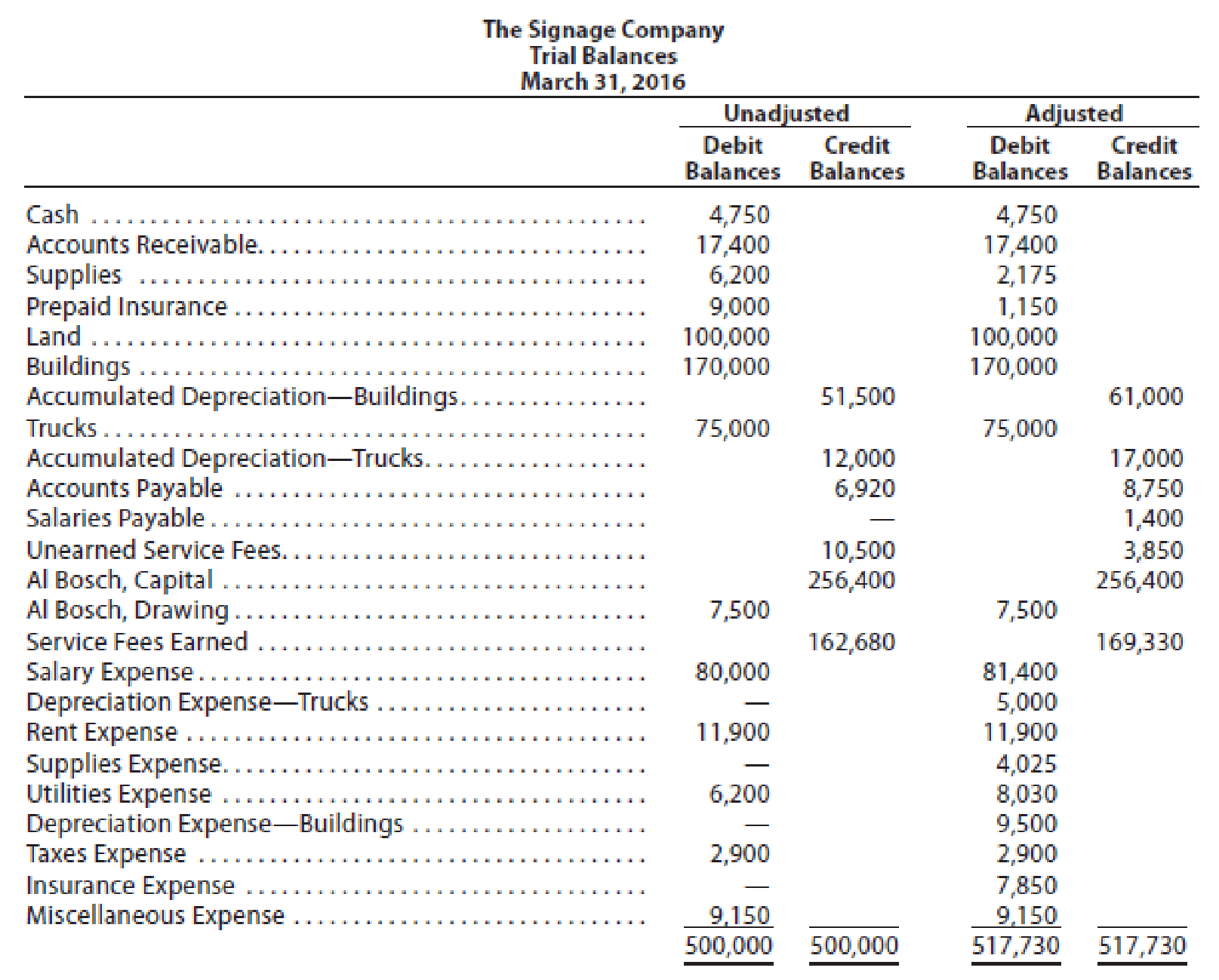
Concept explainers
The Signage Company specializes in the maintenance and repair of signs, such as billboards. On March 31, 2016, the accountant for The Signage Company prepared the following

Instructions
Journalize the seven entries that adjusted the accounts at March 31. None of the accounts were affected by more than one
Prepare the adjusting entries in the books of Company S at the end of the year.
Explanation of Solution
Adjusting entries: Adjusting entries refers to the entries that are made at the end of an accounting period in accordance with revenue recognition principle, and expenses recognition principle. All adjusting entries affect at least one income statement account (revenue or expense), and one balance sheet account (asset or liability).
Rules of Debit and Credit:
Following rules are followed for debiting and crediting different accounts while they occur in business transactions:
- Debit, all increase in assets, expenses and dividends, all decrease in liabilities, revenues and owner’s equities.
- Credit, all increase in liabilities, revenues, and owners’ equities, all decrease in assets, expenses.
An adjusting entry for Supplies expenses:
In this case, Company S recognized the supplies expenses at the end of the year. So, the necessary adjusting entry that the Company S should record to recognize the supplies expense is as follows:
| Date | Description |
Post Ref. | Debit ($) | Credit ($) | |
| 2019 | Supplies expenses (1) | 4,025 | |||
| March | 31 | Supplies | 4,025 | ||
| (To record the supplies expenses incurred at the end of the year) | |||||
Table (1)
- Supplies expense decreased the value of owner’s equity by $4,025; hence debit the supplies expenses for $4,025.
- Supplies are an asset, and it decreased the value of asset by $4,025, hence credit the supplies for $4,025.
Working note (1):
Calculate the value of supplies expense.
An adjusting entry for insurance expenses:
In this case, Company S recognized the insurance expenses at the end of the year. So, the necessary adjusting entry that the Company S should record to recognize the prepaid expense is as follows:
| Date | Description |
Post Ref. | Debit ($) | Credit ($) | |
| 2019 | Insurance expenses (2) | 7,850 | |||
| March | 31 | Prepaid insurance | 7,850 | ||
| (To record the insurance expenses incurred at the end of the year) | |||||
Table (2)
- Insurance expense decreased the value of owner’s equity by $7,850; hence debit the insurance expenses for $7,850.
- Prepaid insurance is an asset, and it decreased the value of asset by $7,850, hence credit the prepaid insurance for $7,850.
Working note (2):
Calculate the value of insurance expense.
An adjusting entry for depreciation expenses-Buildings:
In this case, Company S recognized the depreciation expenses on buildings at the end of the year. So, the necessary adjusting entry that the Company S should record to recognize the accrued expense is as follows:
| Date | Description |
Post Ref. | Debit ($) | Credit ($) | |
| 2019 | Depreciation expenses –Buildings (3) | 9,500 | |||
| March | 31 | Accumulated depreciation-Buildings | 9,500 | ||
| (To record the depreciation expenses incurred at the end of the year) | |||||
Table (3)
- Depreciation expense decreased the value of owner’s equity by $9,500; hence debit the depreciation expenses for $9,500.
- Accumulated depreciation is a contra-asset account, and it decreased the value of asset by $9,500, hence credit the accumulated depreciation for $9,500.
Working note (3):
Calculate the value of depreciation expense-Equipment.
An adjusting entry for depreciation expenses-Trucks:
In this case, Company S recognized the depreciation expenses on trucks at the end of the year. So, the necessary adjusting entry that the Company S should record to recognize the accrued expense is as follows:
| Date | Description |
Post Ref. | Debit ($) | Credit ($) | |
| 2019 | Depreciation expenses –Trucks(4) | 5,000 | |||
| March | 31 | Accumulated depreciation-Trucks | 5,000 | ||
| (To record the depreciation expenses incurred at the end of the year) | |||||
Table (4)
- Depreciation expense decreased the value of owner’s equity by $5,000; hence debit the depreciation expenses for $5,000.
- Accumulated depreciation is a contra-asset account, and it decreased the value of asset by $5,000, hence credit the accumulated depreciation for $5,000.
Working note (4):
Calculate the value of depreciation expense-Trucks.
An adjusting entry for utilities expenses:
In this case, Company S recognized the utilities expenses at the end of the year. So, the necessary adjusting entry that the Company S should record to recognize the accrued expense is as follows:
| Date | Description |
Post Ref. | Debit ($) | Credit ($) | |
| 2019 | Utilities expenses (5) | 1,830 | |||
| March | 31 | Accounts payable | 1,830 | ||
| (To record the utilities expenses incurred at the end of the year) | |||||
Table (5)
- Utilities expense decreased the value of owner’s equity by $1,830; hence debit the utilities expenses for $1,830.
- Accounts payable is a liability, and it increased the value of liability by $1,830, hence credit the accounts payable for $1,830.
Working note (5):
Calculate the value of utilities expense.
An adjusting entry for salaries expenses:
In this case, Company S recognized the salaries expenses at the end of the year. So, the necessary adjusting entry that the Company S should record to recognize the accrued expense is as follows:
| Date | Description |
Post Ref. | Debit ($) | Credit ($) | |
| 2019 | Salaries expenses (6) | 1,400 | |||
| March | 31 | Salaries payable | 1,400 | ||
| (To record the salaries expenses incurred at the end of the year) | |||||
Table (6)
- Salaries expense decreased the value of owner’s equity by $1,400; hence debit the salaries expenses for $1,400.
- Salaries payable is a liability, and it increased the value of liability by $1,400, hence credit the salaries payable for $1,400.
Working note (6):
Calculate the value of salaries expense.
An adjusting entry for unearned service fees:
In this case, Company S received cash in advance before the service provided to customer. So, the necessary adjusting entry that the Company S should record for the unearned fees revenue at the end of the year is as follows:
| Date | Description |
Post Ref. | Debit ($) | Credit ($) | |
| 2019 | Unearned service fees | 6,650 | |||
| March | 31 | Service fees earned (7) | 6,650 | ||
| (To record the unearned service fees at the end of the year) | |||||
Table (7)
- Unearned service fees are a liability, and it decreased the value of liability by $6,650, hence debit the unearned service fees for $6,650.
- Service fees earned increased owner’s equity by $6,650; hence credit the service fees earned for $6,650
Working note (7):
Calculate the value of service fees earned.
Want to see more full solutions like this?
Chapter 3 Solutions
Financial Accounting
- I need help with this general accounting question using standard accounting techniques.arrow_forwardCan you solve this general accounting question with accurate accounting calculations?arrow_forwardI am searching for the correct answer to this general accounting problem with proper accounting rules.arrow_forward
 Financial AccountingAccountingISBN:9781305088436Author:Carl Warren, Jim Reeve, Jonathan DuchacPublisher:Cengage Learning
Financial AccountingAccountingISBN:9781305088436Author:Carl Warren, Jim Reeve, Jonathan DuchacPublisher:Cengage Learning Financial AccountingAccountingISBN:9781337272124Author:Carl Warren, James M. Reeve, Jonathan DuchacPublisher:Cengage Learning
Financial AccountingAccountingISBN:9781337272124Author:Carl Warren, James M. Reeve, Jonathan DuchacPublisher:Cengage Learning

